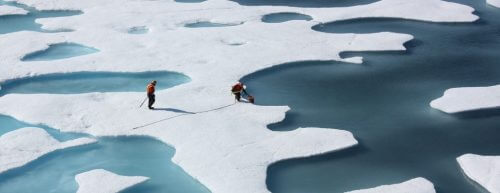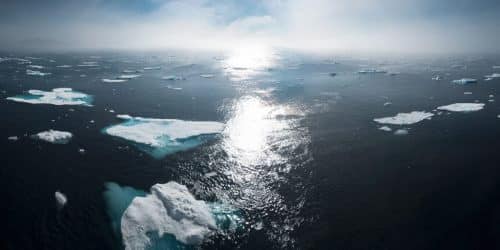The melting rate of the ice in the North Pole continues to increase and worries the experts. Now a group of scientists is proposing to place a system of huge and expensive water pumps at the Pole, which will help keep the Arctic Ocean frozen even in the summer
Maya Falah, Angle - news agency for science and the environment

What do pineapple-flavored creative have in common, the North Pole, and Levy Lion? If you answered that they are all white and frozen, your answer will probably soon no longer be correct: the North Pole, according to experts, is expected to become completely ice-free during the summer season as early as 2030 - this is according to its current melting rate and the temperatures that have prevailed there in recent years.
Climate experts have been concerned in recent months about the high temperature records that are breaking at the Pole, as well as the amounts of ice that are melting at an increasing speed and the scant ice cover in the summer months: just last year, a report by the American Space Agency (NASA) and the American Oceanic and Atmospheric Agency (NOAA) was published. About the alarming situation of the North Pole, and this year, warm temperatures about 20 degrees Celsius above the average for the season measured at the Pole in the winter months are causing the ice to melt even faster.
An ice-free pole in summer has serious consequences, less ice means less energy returned from the vast white surfaces (the albedo effect) and therefore accelerated warming of the earth. In addition, this has enormous effects on the ecosystem, on the local communities and on the animals in the Pole. Therefore, scientists are frantically searching for a solution that will help delay the melting of the polar ice. In an article recently published in the scientific journal Earth's Future, scientists propose a new and revolutionary (and very expensive) idea: to build a system of water pumps that will help refreeze the pole.
10 million pumps
It sounds strange, but the scientists are talking quite seriously about the distribution of many water pumps - about 10 million of them to be exact - driven by wind energy, in the Arctic area. The pumps will pump water that is under layers of ice, and splash the cold water on the surface. The contact with the ice will cause the cold water to freeze and thus a new layer of ice will be formed on the surface that will thicken the ice cover of the North Pole by an additional meter compared to the existing layer (the thickness of which today is only about 3-2 meters at the peak of the cold season).
According to the scientists, the Pole is currently warming twice as fast as previously predicted by models, and they claim that the goals set in the Paris Agreement - which was signed at the end of 2015 and finally ratified at the end of 2016 at the Marrakesh summit - are not enough to significantly slow down the melting of the ice. Because according to the current rate of melting, already in 2030 the North Pole is expected to experience its first summer that will be completely ice-free. Even worse, by the year 2050 the Pole is expected to experience periods in which for five consecutive years the Arctic summer will be ice-free. Therefore, according to them, reducing our greenhouse gas emissions alone is no longer enough, and engineering solutions that will help delay the melting of the ice must also be taken at the same time.
Some? 500 billion dollars
The cost of the program that will cover 10 percent of the polar surface is estimated by the scientists at about 500 billion dollars (!) for ten years, but they claim that this is a necessary matter. A summer without polar ice means a faster warming of the earth, because the great white surface is currently responsible for returning a considerable amount of solar radiation to space, and if the ice cover disappears in the summer, the radiation will be absorbed by the ocean water (the darker a surface is, it absorbs more radiation) and will cause the warming of the area even more so. The warming of the polar region will also affect the warming of the rest of the world: the smaller the temperature difference between the pole and the equatorial and tropical regions (midlatitudes), the greater the frequency of extreme events such as tropical storms, storms and prolonged cold events.

A bear, a moose and a seal meet
The melting of the poles will have a severe impact on the local system: in the polar region itself, the ecosystem is expected to change beyond recognition as the ice continues to melt: the current state of affairs is already making it difficult for the polar bears, whose diet usually relies on hunting seals on floating ice surfaces. The bears are forced to find other prey and the seals themselves find it difficult to manage without the ice blocks and are forced to gather en masse on the continent - in gatherings of thousands of items. This fact makes it difficult for them to find food and causes the crushing of many of the soft puppies that are born in the spring season. The reindeer living near the North Pole are also in a problem as the ice balance changes: when the temperatures at the Pole rise, it rains instead of snow, and the cold waves that come afterwards cause the ice to freeze into a hard layer (as opposed to the soft snow), which does not allow the reindeer to dig with their feet and reach food. In this way, in the last few years, two huge incidents of deer mortality in the tens of thousands have occurred in the Yamal region of Siberia.
The local indigenous communities in the area are also expected to suffer badly from the change: some of them - like the old Hennet community in Yamal, for example - lose their main source of livelihood with the destruction of the ecosystem and the death of the animals. In addition, the ocean and the producers that will be wide open when the summer is ice-free will allow commercial companies to try and use the area's resources (such as gas and oil exploration in areas that currently do not allow passage), which may severely damage the way of life of the local communities as well as create a serious risk of pollution in the area since oil leaks in the temperature Close to stagnation, they will not undergo biological decomposition. Some of these communities have been living in the area for more than a thousand years and some still maintain a simple and traditional way of life.
There is no doubt that investing 500 billion dollars in a system that will help "freeze" the North Pole sounds like a radical idea; But compared to all the damages that will happen with the melting of the ice, it seems that this price tag is low in relation to what we will have to invest later in repairing the damages. With ice shrinking every decade by about 13 percent on average and new polar melting and warming records almost every year in recent years, it seems that even extreme and expensive solutions should be seriously considered.

14 תגובות
Delicious
Sounds quite reasonable
Even if we say implement your white surfaces idea, all the melting ice will turn into water and flood the earth, and countries like the Netherlands or islands will be in a crisis of flooding their entire country, this solution we also offer a solution to the ecological problem.
And let's not say and they will do it... "raise" the water above the ice, or there will be ice on top of the air and the air pockets will be warm and in the end there will be "ice sinks" or the water level will go down in the dark, it will do... who knows, don't try to play in nature, touching a small oris 10 Other things, leave her life dead and a certain area, it's true that it's unpleasant, but what happens around the carrion, the area comes back to life, flies, carrion eaters and other predators arrive, evict the Nesla there is nothing
"A summer without polar ice means a faster warming of the Earth, because the great white surface is currently responsible for returning a considerable amount of solar radiation to space, and if the ice cover disappears in the summer, the radiation will be absorbed by the ocean water (the darker a surface is, it absorbs more radiation) and will cause it to warm of the region even more
I see that I have been preempted, but this is really the first thing that came to my mind, if the whole point here (leaving aside for a moment the issue of the animals that live there) is a white surface that will reflect the sun's rays, what is the problem with spreading huge floating white surfaces that will do this? It sounds much simpler and cheaper to me than the grandiose operation described here... Another option presented in one of the episodes of "Save the Earth" (I think I'm wrong about the name) is to spread a huge cloud of lenses in the space between us and the sun, a cloud that will cast a shadow on the Earth and will reduce the amount of energy that reaches us from it (several other interesting ideas were presented there).
I did not understand why the water would freeze from the ice - it is more likely that the water would melt the ice.
If you want to return the solar radiation, you can spread floating white surfaces that will return the radiation.
Scientists and engineers should focus on nuclear fusion reactors. When this happens, it will be possible to freeze the oceans at the energy price of a bucket of water. (well...maybe a barrel)
With this amount, it is better to build water desalination plants for the drought areas in Africa.
This may be one of the dumbest ideas I've ever heard, if not the dumbest.
Better for the scientists to finally tell the truth
The end of the world is very near
"Reducing our greenhouse gas emissions alone is no longer enough, and at the same time engineering solutions must also be taken to help delay the melting of the ice."
As far as we can see, greenhouse gas emissions can and should be reduced much, much more. It is better to invest the 500 billion in encouraging companies and individuals to reduce emissions.
Israel has already committed twice to reduce emissions, but has not committed to complying with the agreement (especially in the area of clean energy!!). Likewise, car manufacturers can be subsidized, encouraged, and required to switch to producing 50% of their vehicles as electric vehicles in the next 7 years. The subsidy will cover them Some of the losses, but... this will be an investment for the next decades and not for the next decade only.
I think that in the field of automobiles we must lead a very hard hand.
Only one problem concerns humanity: Amona Pamona
It is better to send mirrors into space to repel the sun's radiation, and it will also allow control of the weather
Surfaces of mirrors are made of light and durable material
There is one small problem: the air temperature at the North Pole was about 0 degrees Celsius at the end of December. Sea water freezes at -18 degrees. That is, the North Pole may have already warmed enough that the plan won't work. The program will only work if the air temperature is less than -20 for a long period of about 3 months every winter.